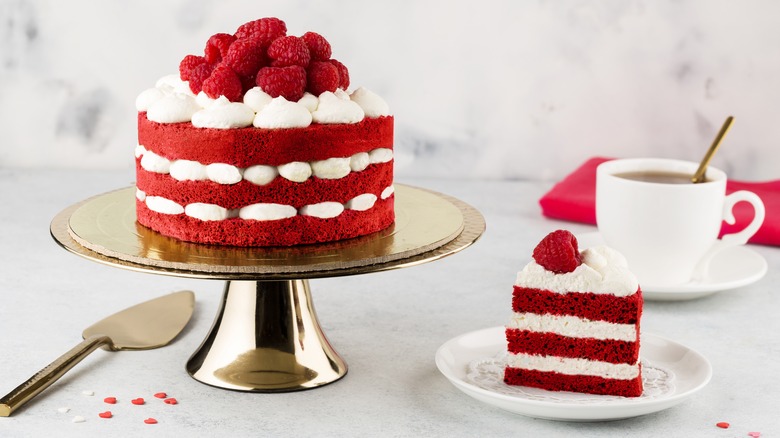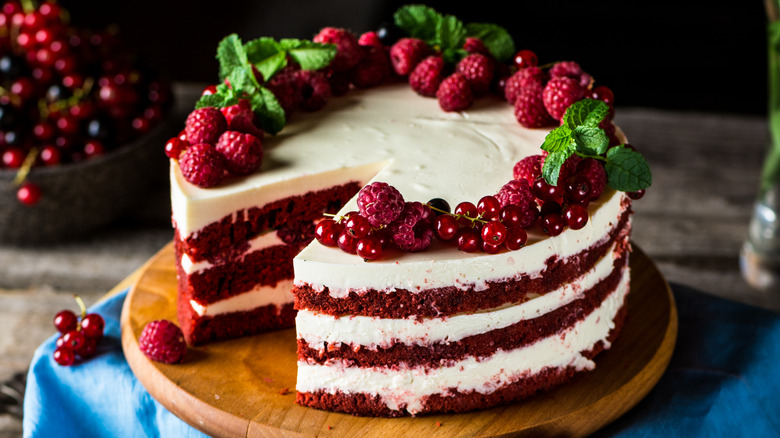Wine Is The Vibrant Ingredient That Brings More Color To Red Velvet Cake
There are many reasons you might want to steer clear of red food dye for coloring the next time you make a red velvet cake. Maybe you're allergic to it, maybe you'd rather not use dyes, maybe you ran out and your cake batter is more pink than red, or maybe you had an accidental spill that made your kitchen look somewhat unsettling. Whatever the case, there are alternatives to red food coloring that don't require placing an Amazon special order for beet powder. Indeed, you might have a bottle of a terrific crimson colorant already kicking around your kitchen: Red wine.
Cookbook author Stella Parksuses 1 ½ cups of dry red wine in her red velvet cake. The color will be pale when the batter is raw, but it will develop into a deep burgundy in the oven. This method won't yield bright, stop-sign-red cake layers, but they will be reddish.
The "dry" part of dry red wine is quite important. Dry means that there is little to no residual sugar in the wine; it all got fermented out. If you have an off-dry, semi-dry, or sweet red, it can become difficult to adjust for the additional sugar in the recipe. Parks uses a cabernet sauvignon: Full-bodied, fruity, and deep red. Zinfandel or a deep pinot noir can be used, but maybe avoid the grassy notes of a cabernet franc.
Why does it work?
Red wine, like red grapes, red and purple berries, beets, red cabbage, and many other "red" foods, contains anthocyanins. These compounds are what give plants a red or purple color. It's also found in cocoa powder. Specifically, raw, natural cocoa powder; the alkalizing process that Dutch-processed cocoa goes through neutralizes the color from a brick red to a dark brown.
Anthocyanins are pH reactive. That's why adding lemon juice to red cabbage makes it change color, turning it into a super bright, vibrant pink. The same thing happens with the anthocyanins in cocoa powder when an acid is introduced. Many recipes for red velvet cake use buttermilk, which is already acidic, but amp up the acidity with a shot of white distilled vinegar. The anthocyanins in the natural cocoa powder react to the low pH of these ingredients and bake up redder. Wine, too, is acidic — and comes with its own anthocyanins. Stella Parks's red velvet cake completely swaps the acidified buttermilk for red wine, activating the redness of the raw cocoa.
Color and taste
The resulting cake, according to various posters and bakers on social media who have made it, is a brighter-colored chocolate cake that can be considered to be red with either a sharp eye or a little imagination. There is "the barest hint of burgundy... if you tilt your head to the side. And catch it in the right light. And maybe use your imagination a little," according to a baker on X, formerly known as Twitter. Right out of the oven, it might look more like a brown chocolate cake, but once you cut into it, you will see there is a difference in the interior color.
"Didn't turn out super red, but I'd say more red than a usual chocolate cake," reported another baker on Reddit. One commenter asked if you'd know it was a red velvet cake with your eyes closed. The jury is still out on that, but another poster did chime in that the taste of red wine red velvet cake is distinct from the devil's food cake recipe from the same cookbook. The bitterness of the raw cocoa and the tanginess of the wine in the batter will create that undeniable red velvet taste, even if the color isn't as bright as you're used to. Regardless of the color, the original poster on the Reddit thread did proclaim that a red velvet cake made with red wine to be "absolutely the best cake I've ever made."


